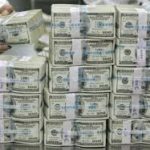China’s slowing growth rate should not be a worry but an unresolved trade war between the world’s two largest economies should be, Paul Gruenwald, chief economist at S&P Global Ratings, told CNBC on Monday.
“We’ve been arguing for some time that China slowing from a 7-8% back then to a 5.5% is a broadly healthy development,” Gruenwald told CNBC’s “Squawk Box,” adding that China’s labor force is currently “either flat or shrinking,” therefore the GDP per capita growth is still strong.
In fact, the strained trade relationship is putting a greater dent on global growth than the direct impacts of tariffs he argued.
“All the uncertainty around U.S.-China (trade relationship) is putting a damper on investments. You don’t know where the world’s two largest economies are going and what the investment environment is going to be,” he said.
Uncertainty looms over the trade war
As the trade war intensifies, many American companies are moving supply chain logistics out of China and into Southeast Asian nations, namely Vietnam and the United States’ southern neighbor, Mexico.
But that supply chain reconfiguration between U.S. companies and Chinese manufacturers is not significant enough to move “the macro data,” Gruenwald argued.
What is affecting investment sentiment and long-term plans for companies is that they are uncertain about how to execute their five-year strategy plans, he said, and that is why companies are dialing back on spending.
“That overhang has been with us for a while now and we’ve been arguing that’s putting a damper on global growth,” said Gruenwald.
S&P Global Ratings’ estimated tariffs led to a 25 basis points affect on growth in both the U.S. and China, Gruenwald said. He added that the “somewhat nebulous confidence affect” seems to have a “bigger drag on growth” than tariffs.
Washington and Beijing have been caught in a protracted trade war since early last year, and the next tariff deadline is Dec. 15.
The two sides have agreed to a “phase one” deal in October, but officials in Beijing say they don’t anticipate sitting down to discuss a “phase two” deal before the U.S. election, in part because they want to wait to see if Trump wins a second term.
And if the two sides cannot pen a deal by mid-December, additional U.S. levies on Chinese exports will go into effect.
″(The Dec. 15 round of tariffs) – that one is going to be different because the first couple of rounds were in capital goods. So, the supplier can take a hit or somebody in the supply chain can take a hit, which push prices up a little bit,” he said.
“If it’s consumer goods, and all of a sudden its your iPhone in your pocket that is 15% to 20% more, that hits the consumers directly, that’s got a political element as well,” said Gruenwald.
Overall, the economist said that investors shouldn’t worry about a slowing growth rate for China. The bigger problem to worry about is the uncertainty looming over the U.S.-China trade relationship that has an affect on each of the economies as well as global growth and the issue is unlikely to be resolved any time soon.




